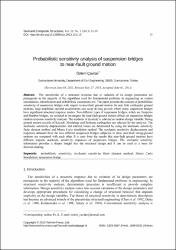Probabilistic sensitivity analysis of suspension bridges to near-fault ground motion

Göster/
Erişim
info:eu-repo/semantics/closedAccessTarih
2013Erişim
info:eu-repo/semantics/closedAccessÜst veri
Tüm öğe kaydını gösterÖzet
The sensitivities of a structural response due to variation of its design parameters are prerequisite in the majority of the algorithms used for fundamental problems in engineering as system uncertainties, identification and probabilistic assessments etc. The paper presents the concept of probabilistic sensitivity of suspension bridges with respect to near-fault ground motion. In near field earthquake ground motions, large amplitude spectral accelerations can occur at long periods where many suspension bridges have significant structural response modes. Two different types of suspension bridges, which are Bosporus and Humber bridges, are selected to investigate the near-fault ground motion effects on suspension bridges random response sensitivity analysis. The modulus of elasticity is selected as random design variable. Strong ground motion records of Kocaeli, Northridge and Erzincan earthquakes are selected for the analyses. The stochastic sensitivity displacements and internal forces are determined by using the stochastic sensitivity finite element method and Monte Carlo simulation method. The stochastic sensitivity displacements and responses obtained from the two different suspension bridges subjected to these near-fault strong-ground motions are compared with each other. It is seen from the results that near-fault ground motions have different impacts stochastic sensitivity responses of suspension bridges. The stochastic sensitivity information provides a deeper insight into the structural design and it can be used as a basis for decision-making.

















